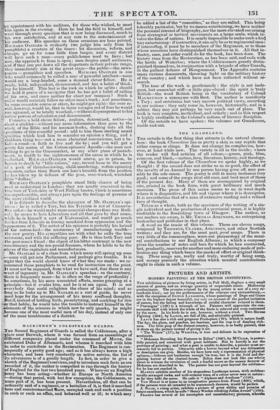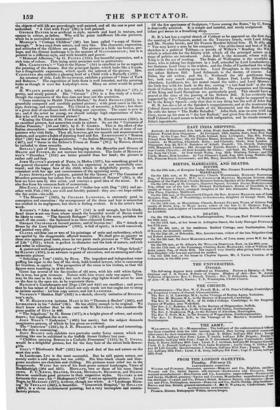PICTURES AND ARTISTS. "
MODERN PAINTING-3 AT THE BRITISH INSTITUTION.
THE exhibition of pictures by living artists, in Pall Mall, displays a very small amount of genius, and an average quantity of respectable talent. Mediocrity
predominates. The promise evinced by the young artists is not of a very re-
markable kind ; nor are the performances of the veterans very extraordinary,— with the exception of Enwix LANDSEER, whose paintings of Dogs and Game
are in the highest degree beautiful, not only on account of the perfect-imitation of nature, but the feeling and knowledge of anirlial character evinced in them. "Ptarmigan" (129) is a triumph of art. Painters will appreciate the con-
summate skill with which the white of the birds is relieved and even contrasted by the snow. In his birds he is not, however, without a rival. Two Herons Fighting (234), by LANCE, are full of life, and admirably painted. LANCE has also a rich and gorgeous Fruit-piece (70), which is nature itself. The figs, the plum, and peaches, are luscious, and the cup is of dazzling rich- ness. The little peep of the distant country, however, is so badly painted, that k shuts up the picture instead of giving it air. "The Widow" (17), by WEBSTER, is true and delicate in its expression of sentiment.
"Mokanna Revealing his Features to Zelica" (340), by 3PCiass,. is power- fully painted, and conceived with great boldness. But to horrify is not the
province of painting; and what a poet is unable to describe, a painter must ne- cessarily fail to portray. Obscurity adds a horror beyond what any delineation or description can give. Besides, we have here only a representation of physical ugliness,—hideous and loathsome enough 'tie true, but it is the livid and dis- gusting horror of the charnel-house. Zelica does not look like one whois about to witness the revelation of such a fearful secret as the unseen features of Mokanna are described to be. The painter has not gone beyond the sublime—. for he has not reached it.
MARTIN exhibits another of his stupendous Landscape scenes, with architec- turally-arranged rocks, and well-ordered trees, of a colour never seen in nature: SO far they befit the scene. He calls it "Alpheus and Arethusa" (118). Vox HoLsr is at home in an imaginative picture from Faust (409), which, if the persons were a intended to be scaramouch daeinons, would be perfect. J. NA sn, a rising artist, exhibits a picture of great ability and promise of future excellence, which he calls" Henry Warden rebuking Julian Avenel" (519. FRASER has Several of his incomplete and unsatisfactory pictures, whereas
the objects of still life are provokingly well painted, and all the rest is poor and unfinished. " A Girl with Fruit" (98) is well painted.
Groans HATTER is as artificial in style, smooth and hard in texture, and opaque in colour, as before. Why will lie paint indifferent life-size pictures, when he is unrivalled in miniature?
MORTON'S " Cottage Children" (92) has been called " a copy of Gains. borough." It is a copy from nature, and very like. The character, expression, and attitudes of the children are good. The picture is a little too browu, per lisps, and the distant landscape is in the manner of GAINSBOROUGH; but it is painted in a different style, and with breadth and power. "Maternal Affection," by G. PATTEN (112), has beautiful expression, and a rich tone of colour. This rising artist promises well in portraiture. Mrs. CARPENTER'S " Visit to the Harem " (24) is excellent as far as regards the painting of the dresses. But the pi incipal figure, which looks like a female, has a disagreeable expression, which spoils the interest of the picture. Mrs. CARPENTER also exhibits a pleasing bead of a Child with a Butterfly (529). An amateur of title, Lady BuRCHE esti, exhibits a picture of " Isaac of York and Rebecca." The expression of both faces is well intended, and the painting- looks as though it were her Ladyship's own. Many an artist would be proud of it.
H. WYATT'S portrait of a lady, which he entitles " A Solicitor " (9), is pretty, and nicely painted. His " Corsair " (78) is a fine study of a head ; though the expression of the face does not bear out the quotation. "Jesus restoring to Health Peter's Mother," by JOHN BRIDGES (252), is a gracefully composed and carefully painted picture ; with great merit in the de- sign, drawing, and expression. The Christ is, of necessity, a failure ; but there is a great deal of excellence both of feeling and execution. The name is new to us ; and if the artist be young, we should indulge high expectations of him. But who will buy an historical picture ? "Kissing the Chains of St. Peter at Rome," by R. EDMONSTONE (324), is an excellent picture, but somewhat crude in colour. So are the "Costumes of Italian Peasants," (58 and 120), by E. F. GREEN. This is the effect of the Italian atmosphere: nevertheless it is better than the brown hue of sonic of our painters who visit Italy. They all, however, get too smooth and monotonous in texture, and acquire a habit of painting hard and flat. EDMONSTONE'S "Roman Girl" (69) has less of this peculiarity. "Au Italian Marriage," by J. BRIDC ES (467), and "Scene in the Debtor's Prison at Rome" (91), by Roons, should be included in these remarks.
BOXALL'S pair of fancy females, belonging to the Beauties and Graces Of HEATH and FINDRN, do not increase his reputation. The limbs of MIDDLE- TON'S "Dorothea" (119) are better painted than her head ; the picture is rather cold and liny. Joint HATTER'S portrait of Pasta, in Medea (107), has something grand in the general character of the head, but the expression is not successfully con- veyed; and the happy face of the child, which is delightfully pretty, is not consistent with her age and aonsciousness of the agonizing scene. JAMES STEPHANOFF'S picture, painted for the Queen, of" The Countess of Montfort presenting her infant Son to the Inhabitants of Rennes" (96), is the best we have seen by this artist, and conveys a good idea of the scene. It is also free from his common fault of mannerism.
Miss EMMA JONES'S two pictures of "Sailor-boy with Dog" (68) and an- other with Fish (181), are well and forcibly painted : they are-we hope unlike the fair artist-too cold.
" The Mourner" (163), by CHARLES LANDSEER, is extremely good in conception and execution: the arrangement of the dress and hair is somewhat too studied in its negligence, but there is feeling evident. It is the artist's best work.
KiarouT's "John Anderson my Jo" (14) is well enough, but his black- faced dame is not one from whose mouth the beautiful words of Burns would be likely to come. "The Spanish Refugees 'S (236), by the same, partakes too much of the comic : the Spaniard is an olive-coloured Liston.
Gaortox CRUIESHA NE turned painter, and of heroics too! His "Attack on Bruce by the Lorn Highlanders" (316), is full of spirit ; it is well conceived, and painted very ably. CRATER exhibits one or two of his paintings of satin and embroidery, which are spoiled by the disagreeable affected wearers. We shall give no quarter to these sins against good taste, since he can paint such pictures as "The Winter of Life" (472); which is perfect in character and the look of nature, and rich and sober in colouring. A quaint and well-painted picture of " The Examination of a Village School," by HARVEY (478), is an advance in point of execution, and an amusing and cha- racteristic picture.
"Soliciting a Vote" (443), by Buss. The impudent and independent voter puffing his cigar in the face of the sleek, bald-headed lawyer, who is canvassing for Guttlem, is capital. The perspective of the room is too violent, so that the figures seem tumbling in at the door.
GOOD has several of his fac-similes of old men, with his cold white lights. He is true, but gets tiresome. Nature with him wears only one aspect. This may be the case in his study ; but such sharp edgy lights would never be seen on the face in the open air, is he represents them. HANCOCK'S Gamekeepers and Dogs (158 and 444) are excellent ; and prove that he has talent of that kind which not only needs not but ought not to stoop to imitate another : let him copy nature, and not La NDSEElt. VICKERS'S "Haddon Hall" (382) is a sketch, cleverly imitative of BONING- TOVS style.
W. N. HARDWICKE imitates Hater in his " Thomas-A-Becket" (503), and LIVERSEEGE in his "Juliet" (36). He has ability enough to be original. We don't know whether that be the ease with W. KENNEDY, who emulates the gross quality of ETTY in 480.
"The Suppliant," by H. Room (417), is a bright piece of colour, and nicely drawn; but suppliant she is not.
JOHN WOOD'S " Endymion" (483) has merit ; but the subject demands imaginative powers, of which he has given no evidence. The "Interview" (216), by J. R. HERBERT, iS well-painted and interesting, but the title is unmeaning. JOHN EOADEN only exhibits two portraits under fancy names, which are nothing like one he exhibited in the Suffolk Street Gallery last year. "Children carrying flowers in a Catholic Procession" (113), by T. UWINS, would be a delightful picture, but for the foxy hair of the sweet little flower- girls.
GILL'S " Blindrnan's Buff" (282) has a good deal of fun and nature on the most tiny scale.
In Landscape, LEE is the most successful. But he still paints nature, not merely under a cold aspect, but too coldly. His blue-black clouds and blue- green meadows are cheerless and chilling. His pictures want relief too in the foregrounds. WATTS has two of his fresh green natural landscapes, Views of Buckfastleigh c384 and 413). HOFLAND, IWO or three of his tame literal views: F. C.,LEWIS, SHAKER, STARK, HENSHAW, HILDITCH, and Hiram:a likewise contribute good pictures in their respective styles. STANLEY is not fortunate this year; his " Shakspeare's Cliff" is not an agreeable picture. Lyme Regis,.by MARSTON (277), is clever, though too white. A "Landscape Morn- ing" by TENNANT (383), is beautiful. "Greenwich Hospital," by HOLLAND WS),is a clever architectural painting, but a very incomplete and unsatis- factory picture.
Of the few specimens of Sculpture, "Love among the Roses," by C. Sati is deservedly admired. It is simple and tasteful, and nicely sculptured. infant god seems in a breathing sleep.























 Previous page
Previous page